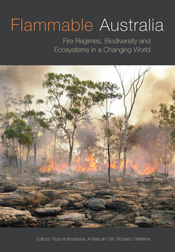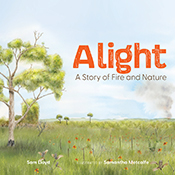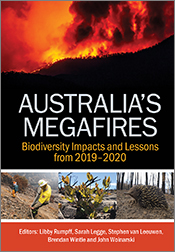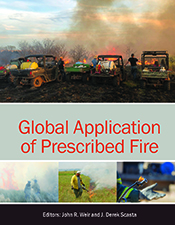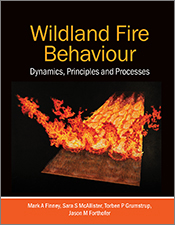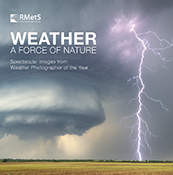Flammable Australia
Fire Regimes, Biodiversity and Ecosystems in a Changing World
Edited by: Ross A Bradstock, A Malcolm Gill, Richard J WilliamsLeading researchers give an overview of the field of fire ecology in Australia.
In Flammable Australia: Fire Regimes, Biodiversity and Ecosystems in a Changing World, leading researchers in fire ecology and management discuss how fire regimes have shaped and will continue to shape the distribution and abundance of Australia’s highly diverse plants and animals. Central to this is the exploration of the concept of the fire regime – the cumulative pattern of fires and their individual characteristics (fire type, frequency, intensity, season) and how variation in regime components affects landscapes and their constituent biota. + Full description
Contributions by 44 authors explore a wide range of topics including classical themes such as pre-history and evolution, fire behaviour, fire regimes in key biomes, plant and animal life cycles, remote sensing and modelling of fire regimes, and emerging issues such as climate change and fire regimes, carbon dynamics and opportunities for managing fire regimes for multiple benefits.
In the face of significant global change, the conservation of our native species and ecosystems requires an understanding of the processes at play when fires and landscapes interact. This book provides a comprehensive treatment of this complex science, in the context of one of the world’s most flammable continents.
- Short descriptionNews
No longer available in a print edition.
Reviews
"This is a well-written, technical book, providing a very good "state of the art" account of fire ecology in Australia."
R.H. Marrs, Biological Conservation, Vol 158 (3) 2013
"This book is written by more than 40 knowledgeable Australian authors and is definitive and, as importantly, accessible by anyone with a modicum of scientific knowledge. A must for the bookshelf."
BES Bulletin, April 2013
"I regard this book as a valuable reference work for fire ecologists as well as students in fire ecology."
Rina Grant-Biggs, African Journal of Range & Forage Science, pp. 91–93, Vol 29(2), 2012
"Flammable Australia covers is all: fuel and habitat, fire frequency before and after European settlement and before and after global climate change; the effect on plants, animals, human communities, even fungi."
Nick Goldie, Summit Sun, March 29 2012
"The book is essential reading for the burgeoning audience of scientists interested in fire as an ecological process operating over diverse temporal and spatial scales"
William Bond, Austral Ecology, 2013
Details
ePDF | February 2012ISBN: 9780643104839
Publisher: CSIRO Publishing
Available from eRetailers
ePUB | February 2012
ISBN: 9780643104846
Publisher: CSIRO Publishing
Available from eRetailers
Features
- This is a unique (i.e. continental-scale) synthesis
- High quality line-up of authors
- The market transcends academia and policy makers
Contents
Evolution and prehistory1 The prehistory of fire in Australasia
2 Fire regimes and the evolution of the Australian biota
Processes
3 Fuel, fire weather and fire behaviour in Australian ecosystems
4 Measuring and monitoring of contemporary fire regimes in Australia using satellite remote sensing
5 Functional traits: their roles in understanding and predicting biotic responses to fire regimes from individuals to landscapes
6 Fire regimes and soil-based ecological processes: implications for biodiversity
7 Global change and fire regimes in Australia
Ecosystems
8 Fire regimes in Australian tropical savanna: perspectives, paradigms and paradoxes
9 Fire regimes in arid hummock grasslands and Acacia shrublands
10 Fire regimes in Australian sclerophyllous shrubby ecosystems: heathlands, heathy woodlands and mallee woodlands
11 Bushfires and biodiversity in southern Australian forests
12 How do fire regimes affect ecosystem structure, function and diversity in grasslands and grassy woodlands of southern Australia?
New challenges
13 Fire regimes and carbon in Australian vegetation
14 A revolution in northern Australian fire management: recognition of Indigenous knowledge, practice and management
15 Future fire regimes of Australian ecosystems: new perspectives on enduring questions of management
Index
View the full table of contents.
Authors
Ross A Bradstock leads a research team that is devoted to understanding how people can co-exist with fire in a sustainable manner. He has special research interests in the field of climate change and landscape modelling, in order to improve the way fire regimes are managed in the future. He has published widely on fire ecology and fire management and has been influential in the development of fire policy in Australia.A Malcolm Gill began his research career in fire ecology in the early 1960s. He has published widely on fire ecology, fire behaviour and fire management with many Australian and international colleagues. He retired from CSIRO after a career spanning more than 30 years and is currently a Research Fellow at the Australian National University where he is engaged on projects dealing with climate change, biodiversity and human risk. He received an Order of Australia in 1999 for his service to the scientific research on fire.
Richard J Williams has researched and lectured in plant ecology for 30 years. He is currently leading research projects on fire regimes and biodiversity and fire regimes and carbon in both tropical and temperate Australia. He has co-edited two books and several journal special issues on fire ecology and management, is on the Editorial Board of the International Journal of Wildland Fire and Plant Ecology, and is a past Member of the Bushfires Council of the Northern Territory.

